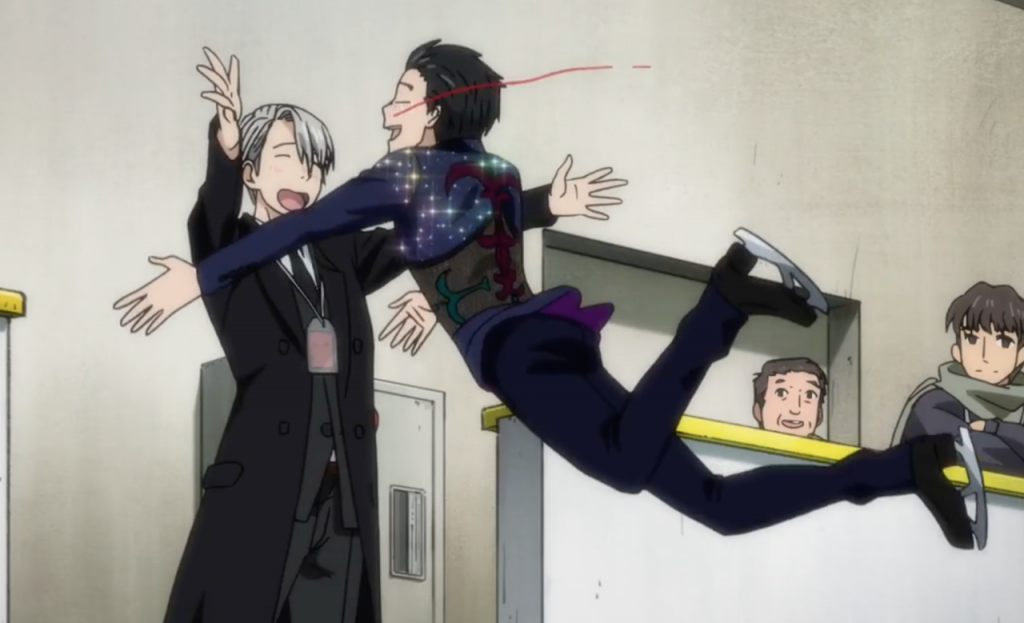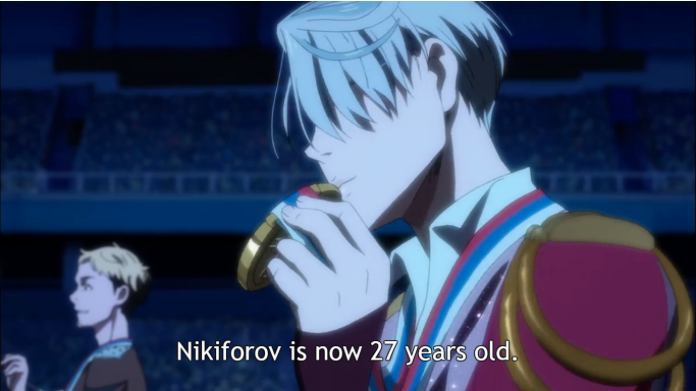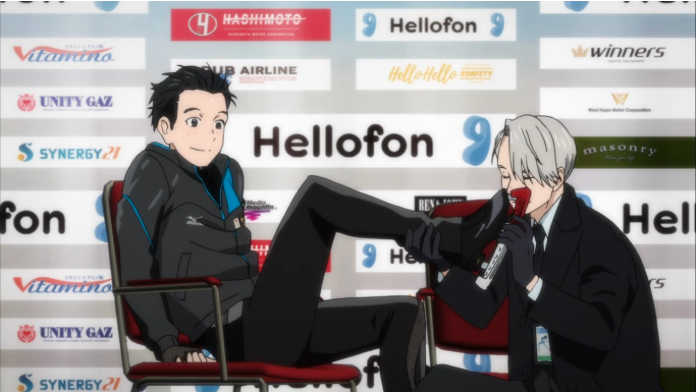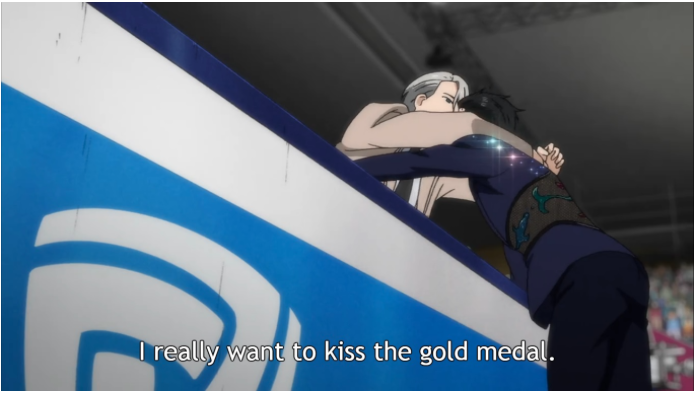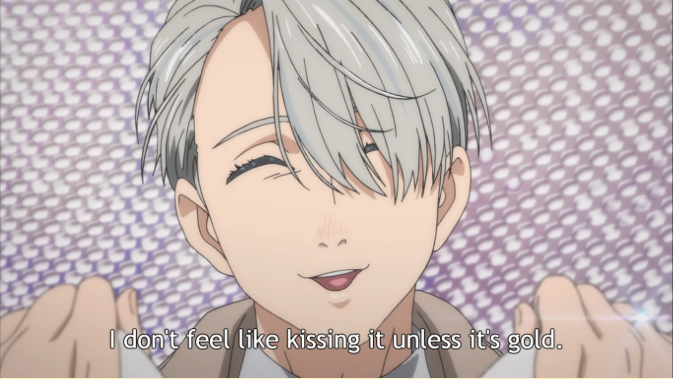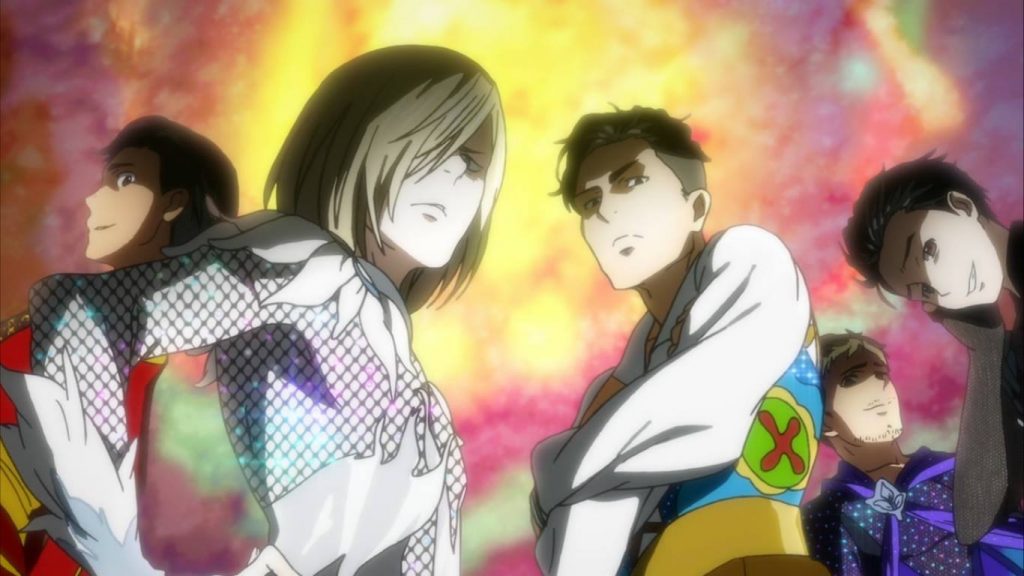Yuri!!! on Ice is a 2016 anime that has captured a global audience through its beautifully choreographed animation, a strong emotional story, and compelling gay representation. Animation Studies 2.0 blog contributors Jacqueline Ristola, Mihaela Mihailova, Caitlin Casiello, and Evelyn Hielkema came together to discuss the show after it finished its run in Japan to dig deeply into the series’ impact as a whole.
Gay Representation:
Caitlin Casiello: I’ll start out by mentioning I wrote an earlier piece on how, in YOI and similar anime, queerness happens through/across the screen, in the interaction between what’s shown and what the fandom imagines. What I was trying to argue for is a mediated queerness somewhere between “we’re gay and say so” overt, deliberate, and political representation and simple subtextual accident. Shows like YOI and a lot of other anime, not just the fujoshi-aimed shows, are built around queerness in a way that’s impossible to read around but also not explicitly stated. When I wrote that post, episode 7 had just aired and I was intrigued about the way they had partially obstructed the kiss at the end, so that you could imagine if it was there or not, even though you were clearly supposed to see a kiss.
One thing I was hesitant to go into in that post, with five episodes left to air, was whether or not YOI specifically is doing something different from other fan service or queer subtext based shows. Ultimately, it does feel to me different because it does seem like there is a relationship going on underneath that just isn’t completely shown, rather than there being a plot with added-in fan service for marketing purposes. Victor and Yūri’s relationship is a romance. This is central to their character development and it is what the show is about, even if the relationship is very much about skating as well. A friend pointed out to me, after the earlier post, that only about 70% of the scenes Kubo actually planned had made it into the show, so I think that is part of it as well: the creators built this show with a whole world in mind, one which we don’t entirely get to see.
For me, the show sets up a central, well-developed, carefully considered queer relationship but leaves the moments which would name or label that relationship one way or another to the fans to imagine. Specifically, it leaves them not just to imagine, but to create fanworks about. Fans will work with whatever they have and change whatever they need to in a canon, of course, but in YOI, there’s no canonical moment which sets up a timeline for Victor and Yūri’s relationship—no confession, no “now we’re boyfriends” moment, they just seem to gradually, steadily, grow closer, until they’re kissing on the ice (which is never discussed or explained) and exchanging rings and pair skating together. For viewers outside of fandom, this either reads as pure romance, no questions asked, or it seems confusing—why aren’t they talking about this? Is this a real proposal?. So I think that, in some ways, talking with other fans and doing/consuming creative fanworks is an important part of the overall viewing experience for YOI. It can’t just be watched in a vacuum, or it can, but you’re not getting all the best parts. YOI’s queerness is built into the community around the show as much as it is the show itself.
Jacqueline Ristola: In talking about gay representation, I want to focus on one moment in episode 5. One thing I just realized is the significance of the nosebleed Yūri gets before running into the arms of Victor. Nosebleeds in anime are typical illustrations of sexual lust, and Yuri!!! on Ice foreground this kind of symbolism multiple times early on in the series with its female characters reacting to the fantastic male figure skaters.
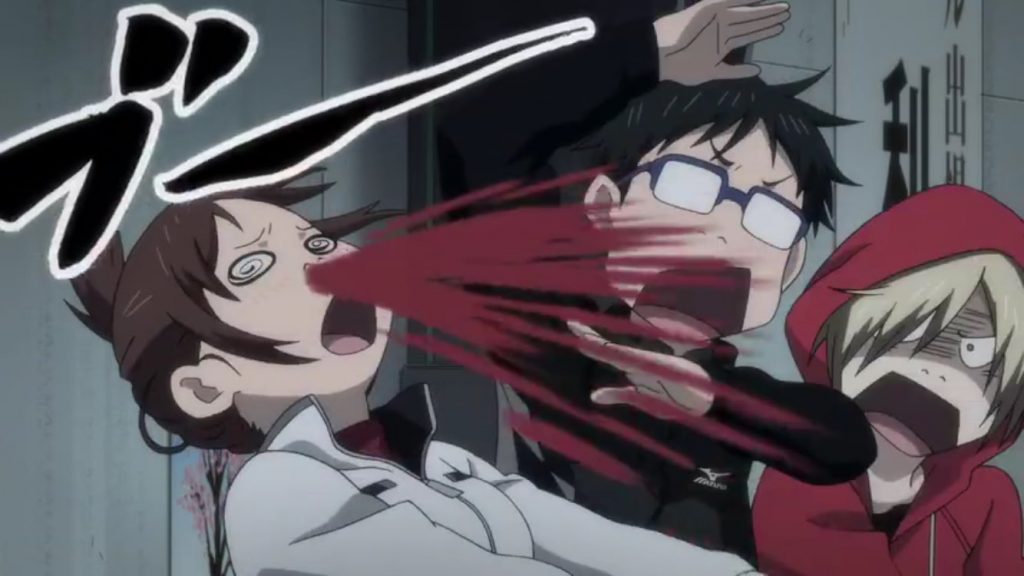
An early example of a female character getting a nosebleed in reaction to the beauty of the male figure skaters.
In the episode, Yūri gets the nosebleed from smacking his face in the wall as he performs his routine in competition. Thematically, this event is a literal manifestation of his current limitations, as Yūri finds himself hitting a wall. Yet, along the way, Yūri’s body also exhibits a symbol of sexual lust and desire, and indication his sexuality has been awakened.
This moment is a perfect illustration of Victor and Yūri’s relationship in the show, and how it develops throughout the series that what, ostensibly, begins as a professional relationship and becomes a romance. It embodies the appeal of the series as well, as the series is vastly entertaining, while also being thematically and symbolically strong.
Tying back to the realism of the show, another thing I’d add is how the show uses the conventions of professional ice skating to support the romantic relationship. Yūri and Victor’s skating duet at the end of the final episode is significant, in that in professional ice skating, the only duo programs that exists are for a male-female duo.
Can I not ache after an episode 12? Can I just say… This is what I wanted all this time!!! #YuriOnIce12 pic.twitter.com/Iruiov5VBP
— Evgenia Medvedeva (@JannyMedvedeva) December 22, 2016
It’s another way for the series to confirm the romantic relationship without the typical trappings of romance in media, while using the mechanics of the skating world, a world that the series and creators Sayo Yamomoto and Mitsurō Kubo dearly love. No wonder why Victor and Yūri are up for “Best Couple” award for 2016.
Mihaela Mihailova: They better get that award! Going off of Jacqueline’s point about the show’s use of sports imagery in support of its central relationship, I’m thinking of the clever tease regarding the “round and golden” object Yūri promises Victor in the preview for episode 10. This phrase – which immediately launched ten thousand Tumblr posts but, amusingly enough, only one ship – would clearly refer to a gold medal in a straight(forward) skating anime. However, this being Yuri!!! on Ice, a queer romcom about the challenges of simultaneously landing a quadruple flip and a handsome boyfriend, hopeful fans were quick to point out that a certain symbol of matrimonial commitment shares those same characteristics. Thus, the great “medal vs ring” debate of 2016 was born (full disclosure: yours truly, motivated by brazen greed for both victory and victuuri, remained firmly in the “why not both?” camp). In addition to creating suspense and fueling fan speculation, this exemplifies the show’s playful use of sports media genre conventions as romance tropes. Of course, this knowing wink at the audience wouldn’t have worked out quite so well had the show not earned it thanks to moments – such as the much-discussed episode 7 kiss – that repeatedly affirm Victor and Yūri’s professional and intimate partnerships as inextricably linked and dependent on each other.
Victor’s own professional and personal journey can also be traced partially through the eroticizing of skating paraphernalia. In episode 1, having just achieved his “fifth consecutive Grand Prix victory,” Victor celebrates this personal career highlight by kissing his medal. The show captures this moment in close-up:
Both the audience and Christophe are out of focus, while the distance between Victor and the Swiss skater appears greatly exaggerated. The kiss reinforces Victor’s competitive drive, whereas the framing emphasizes his singular status as a living skating legend. However, by visually separating Victor from everyone else, the show also hints at his isolation and loneliness, which he will allude to explicitly in episode 11 (“I can only find new strength on my own. That’s what I always thought”).
By episode 8, Victor’s character development is punctuated by another kiss. Now a proud coach and loving partner, the Russian champion gets down on his knees and dramatically smooches Yūri’s skate in a show of admiration:
This is not simply another public milestone in their relationship, but an indication of how far Victor has come throughout the season in committing to his dual role in Yūri’s life. That same duality is emphasized here in the undeniably erotic undertones of Victor’s actions, further reinforcing the role of skating imagery in conveying the development of the show’s central romance.
In the last episode, Victor’s pep talk before Yūri’s routine immediately recalls the YOI’s opening:
This is likely deliberate, as it neatly illustrates both the evolution of Victor’s priorities (it is no longer his gold medal he’s aiming for) and the ways in which Victor and Yūri’s mutual love for their sport is the language they use to communicate their feelings. To this end, the medal – like the skates – becomes an object onto which the subtextual promise of romantic affection can be temporarily displaced.
In the end, Yūri wins silver, and Victor’s response is a cheeky refusal to kiss the medal:
The medal imagery has gone full circle and, in some ways, so has the show’s premise, as Victor announces that he will go back to competitive skating. However, he also plans to remain Yūri’s coach at the same time (YOI is not always realistic), so season 2 promises a lot more kissing – of medals and otherwise.
CC: Misha and Jacqueline, you’re both so right about the use of sports objects as symbols of their relationship. That’s common to a lot of sports anime with gay subtext and, possibly, one of the reasons why these shows began to get a lot of attention from female fans looking for gay subtext. The displacement of intense homosocial bonding on to sports as a safe area for male characters to express their deep feelings for each other is what made the genre pretty damn gay from very early on. YOI is definitely drawing on that genre but, as I think you are saying, folds the romance in much more completely and subtly.
The “gold and round” line, if I can add to Misha’s discussion, is a moment where the show subverts fan expectations for the show to “no homo” the relationship and instead goes for the romantic interpretation. This is a common type of joke in fujoshi-aimed shows: both the sports-related (or otherwise non-romantic) meaning (gold medal) and the romantic meaning (rings) exist at once and fans hold each of them in mind without the meanings contradicting, even though the expected outcome is usually the one that’s not explicitly romantic/sexual: a gold medal. But in this case, the show reversed expectations by not having it be a gold medal at all (Yūri never even won one!). It was literally rings, wedding rings, which were exchanged in a moment that’s visually marked as a vow exchange and later called an engagement, even though there, too, there’s a superficial denial of this being “for luck.” This is the other way these moments work: the text or narrative might have some other explanation but the visual imagery, often more emotionally direct and influential, clearly resonates with romantic or sexual imagery.
Evelyn Hielkema: This is the most difficult of the themes we’ve chosen to address. Because of the cosmically insignificant nature of the topic at hand––it’s only one show that people watch for relief and comfort, after all––I want to avoid treating it with more gravity than it deserves. But I want to contextualize the show and the fan/culture industry relationship to avoid lapsing into the kind of complacency I often sense at the core of these kinds of discussions.
Japan has been an early pioneer of what scholar Robert Biel calls the “systemic turn” in global capitalism that became entrenched in global production and circulation systems in the late 1970s. The country has become well known for more decentralized management styles, its higher valuation of personal trust in the conduct of business transactions, and, in its culture industry, the selective absorption of fan production into the industry from an early date. Fans invest a degree of trust and enthusiasm in their area of interest comparable to interpersonal love, and this bond has become leverage for everything from entry-level recruitment to the use of fan production as a sustained, decentralized marketing process.
Fan enthusiasm and creativity, themselves admirable expressions of human initiative and often the origins of admirable works of art, are linked directly to profit making. While the relationship between fans making dōjinshi and the copyright holders is not the same as that between those same capitalists and (sort of) paid creative staff, both are subordinated to the production and circulation processes of capital. Fans not only spend an enormous amount of money and will often buy something associated with what they love sight-unseen, but also produce an immense amount of free content that will––it is hoped––bring in more fans. Although a fandom is a sub-subculture, a community, an audience for popular and folk art, and the embodiment of human trust and passion, it is also a host body for a parasite.
By its nature, this parasitic relationship is volatile and full of friction. Fan communities are not passive chumps and often reject specific decisions of the parasite, always subjecting the parasite’s inputs to its own far more diverse and idiosyncratic tastes. Fans can even form political blocs that act collectively to veto executive decisions––the Mass Effect 3 ending scandal being a perfect example. So the relationship is mutual and dynamic despite the fact that the legal persons responsible for anime only have an interest in fans insofar as they function as reliable monetary inputs.
Now, LGBT people are only quite rarely the main audience for media campaigns that have any mass corporate scale. From something as innocent as Yuri!!! on Ice to something as deadly as corporate, Canadian, or Israeli pinkwashing of wars in the name of liberal “diversity” politics, the central audience is mostly cis and straight people who feel and desire in ways that implicate us as fetishized objects. Whether they be enlightened straight liberals who want to be pro-gay and pro-war or straight men and women who get off on “gay” and “lesbian” content or even people who find trans women like me a great subject for teary melodrama or freakshow fun, they are the ones who drive the production of “gay-friendly” content.
While Caitlin’s article is right to reject a homogenized idea about what constitutes visibility, I would say that we are right to be suspicious of the reasons why a creator or studio might be content with teasing or suggesting rather than committing to full visibility. So the term “queerbaiting,” while blunt and superficial, does hint at both the ways that all fans are exploited and the specific ways we get fetishized or mistreated in both canonical and fan works. For me the problem is not so much how subtle or blatant the “representation” might be. Rather, the problem lies in the commodification of art and the use of LGBT people as niche fetishes and exotic subject matter by people who don’t care about us or our struggles.
I haven’t spent much time talking about Yuri!!! on Ice specifically, but my reception of the show rests on the kind of understanding I’ve shown above. The show itself is not responsible for any of these larger problems and ends up being a well-constructed piece of work much of the time. I think the rest of the panel has done an excellent job of exploring how YOI has made clever and positive uses of its own genre conventions to tell a romantic story with real worth. I was curious about the history of “subtext”-driven fan appropriations of sports anime in particular, and I rather enjoyed Mihaela’s discussion of how both the characters and the show use the language of sports to communicate personal affection to each other/the audience. It demonstrates the harmony the creators established between the show’s narrative themes and its technique. We could discuss how the show is able to show how other forms of love incarnate themselves in skating routines, in particular young Yuri Plisetsky’s love for his grandfather. But alas, I’ve done enough soapboxing and will leave these questions to the side for now.
CC: I’m glad you brought up these questions, Evelyn, because even though I’ve been taking an overall positive approach to YOI as a fan, it certainly is embedded in an industry where queerness is being commodified and consumed, just as women’s and girl’s bodies are commodified and consumed in other genres of anime. YOI’s first Bluray/DVD topped the animation disc charts with over 50,000 total units sold in its first week; I’m already building up a collection of magazines—for research purposes, of course—and new merchandise selections come every day, it feels like. Sometimes a modified lyric from the opening theme pops into my head: forget making history, we were born to spend money.
But, as you say, this isn’t a problem of YOI itself. The nature of the market involved, the nature of corporate media capitalism itself, applies to every work of mass media, globally, with, perhaps, different cultural/production contexts operating within the anime industry. Fandoms exist as they do because in the age of mass corporate-owned media, the stories that make up culture are privately owned and distributed rather than public creations. Often what fan creations do is try to rework the narratives given into stories which reflect experiences and emotions that have been expunged from or repressed within corporate media—including queerness and, with male/male fanworks, often the potential for masculine emotional expression. This has always been my reading of the origins of slash fanfiction in the U.S. with Kirk/Spock (following Jenkins in Textual Poachers, I believe, though it’s been developed a great deal since): a desire not necessarily to read men kissing, but to read men having emotions outside of the bounds of traditional masculine representation (I mention this because I think that’s also a lot of what’s going on in YOI’s own appeal to the fujoshi audience and the appeal of sports shows in general to fujoshi). With this sort of mostly-female male/male-focused fandom, so often criticized both in Japan and in the U.S. for its fetishization of homosexuality, its fixation on and adulation of men, the exclusion and often demonization of female characters—well, I would never say fandom is what’s going to save us from the commodification of our stories and our bodies as media objects. But creative fanworks often serve to restore, for better or worse, narratives and situations and experiences which have been pushed off-screen. It’s one trajectory through the cultural dominance of corporate, mass-produced media images outside of our control, even though it’s now often anticipated by the content producers as a form of reception which must be both cultivated and controlled.
To go back to YOI specifically: part of the delight of watching it for me was that, because of the genre being what it is, I never expected the level of queerness we got, even if they are commodifying it, even if it is primarily aimed at cis straight women (though I’m an advocate for the Fujoshi Are More Queer Than People Think school of thought). Ultimately, though, I think YOI is an attempt to show a world where queerness, from Victor/Yūri’s relationship to the Johnny Weir costumes references, is positive and healthy, so I tend to give it a pass for the economic context it was born from. However, I still struggle with the question: how do we reconcile happiness at seeing queerness in media with our awareness, particularly as academics with a responsibility to critically engage, that these works are commodifying it, often for the benefit of straight people and often without engaging with queerness as something, potentially, truly other to and critical of heteronormative society?
JR: That’s a great question to ponder as we dive into the final part of our roundtable next week!
Check outs parts one and three of our roundtable on Yuri!!! on Ice!
Bios
Jacqueline Ristola is a Masters student in Cinema and Media Studies at York University in Toronto, Canada. She graduated from Calvin College with a Honours BA in Film and Media Studies. Her research interests include animations and its various incarnations, with her current research project examining the cross-cultural aesthetic exchanges between the Japanese anime Samurai Champloo and the American animated series The Boondocks. She has published articles in Animation Studies and the film magazine Bright Wall/Dark Room. Her presentation at SAS 2016 explored the relationship between Waltz With Bashir and Persepolis to the documentary genre.
Mihaela Mihailova is a PhD candidate in the joint Film and Media Studies and Slavic Languages and Literatures program at Yale University. Her research interests include animation, film and media theory, early Soviet cinema, contemporary Eastern European cinema, video games, and comics. She has published articles in animation: an interdisciplinary journal, Studies in Russian and Soviet Cinema, Post Script: Essays in Film and the Humanities, and Kino Kultura. Her piece“Frame-Shot: Vertov’s Ideologies of Animation” (co-written with John MacKay) is included in Animating Film Theory (ed. Karen Beckman). Her essay “Latvian Animation: Landscapes of Resistance” appears in Animated Landscapes: History, Form, and Function (ed. Chris Pallant).
Caitlin Casiello is a Ph.D. student in the Combined Program in East Asian Languages and Literatures and Film and Media Studies at Yale University. Her current interests include Japanese pornography (live action, animated, pink, adult video) and queer filmmaking in Japan. Her master’s thesis, completed at Harvard University, focused on the legal controversies around and visual techniques of commercially-published pornographic Japanese comic books.
Evelyn Hielkema is a masters student at York University studying Japanese maritime environmental history. Her professional studies encompass the history of disease, global commodity and information flows, energy production, ecology, and the tangled thicket of state bureaucracy. Her one proper presentation was of “Panel Geographies,” a bizarre amalgam of media critique and political economy illuminating the relationship between American comics and the Middle East. To cap off her undergraduate career, she wrote an in-depth study of an American bureaucrat working in Iran during the 1911 Constitutional Revolution. In her spare time, she publishes the Tiger Manifesto blog at tigermanifesto.wordpress.com, reflecting on everything from Marxism to Christian kitsch.

